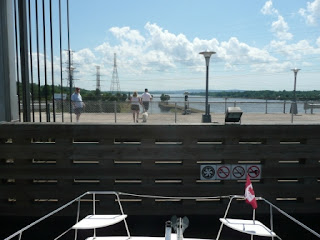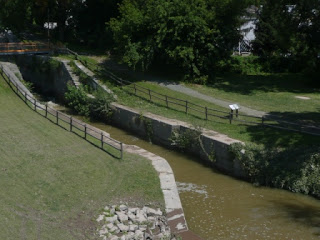It is a good thing we had a close destination planned when we left Ottawa. It actually took us 5 1/2 hours to clear the Ottawa lock flight, four hours of waiting for the up-bound boats and 1 1/2 hours to lock down to the Ottawa River. We finally left Ottawa about 1:45 PM.
During the four hours of waiting, the sun was out, the sky was blue. By the time we got into the lock, it was pouring rain. I shouldn't complain, we've had such great weather most of the trip, but locking in the rain sucks. Jim gets to stand under the after deck cover. I'm standing out in the rain at the mid-ship cleat.
 |
| Through the quarry cut |
Our plan for the evening was to hang out on a free dock available at a local casino. The casino was built next to a mined out quarry, which they flooded to create a marina. To get into the marina you have to take your boat through a blasted out hole in the wall of the quarry. You also have to get under a 19 foot bridge, so the boats that get in there don't tend to be too large. Down Time was put on the "big boat" dock to give us plenty of room. After all those years in Florida where a 36 foot boat is considered small, it is very strange to suddenly be one of the big boats.
Early the next morning we left and headed down the Ottawa River. It was easy and pleasant boating, little wind, calm water, wooded shore lines some with houses, others on islands that are wildlife sanctuaries. As many of you know, I lived in Arizona for years and Canadians flock to Arizona for the winter. I now understand the attraction. It must seem like being on the moon to them after Canada. Everything is green and growing here, everywhere you look.
 |
| Chateau Montebello entrance |
The Ottawa River is not very long. At our typical speed it is an easy two day trip. For our one night stop along the way, we went to Chateau Montebello which bills itself as the world's largest log cabin. This picture of the entrance doesn't begin to give you the sense of its size. I tried to take a picture of the interior reception area which is three stories high with a four-sided fireplace that must be eight feet across, but it was too dark in there for my little digital camera to handle. It is an interesting place, it is a family resort destination; you go there to hangout for a week, there is nothing around it. Your room rental includes golf, kayaking, swimming pools, horseback riding, hiking trails, etc. You can sign-up for classes in any of the above. They even have a Land Rover driving school for folks who want to play off-road driver.
 |
| Carillion Lock loaded - at the top |
Along the Ottawa River you encounter two locks, the deepest lock in the system and the shallowest. Interestingly enough, they both operate differently from the locks on the Rideau Canal. On the Rideau you loop lines around cables attached to the canal walls and adjust the lines by hand as the boat rises or falls with the water. In the Ottawa River locks you tie up to a dock in the lock and the dock itself raises or lowers. In the Carillion Lock this is a good thing because the lock is 65 feet deep. Because it is so deep, it takes a long time to fill or empty it, so they really pack the boats in with each locking. This is where being one of the big boats really comes in handy because they put the big boats into the lock first and tie them off to them floating dock. Then they bring in the smaller boats and tie them to the sides of the bigger boats.
 |
| Looking out before starting down |
We were actually the first boat in so we were at the front of the lock with a view down river before they started letting the water out. About half way through the locking process, this is how our view had changed.
 |
| Half way down |
That is the same gate we were looking over when the process began. At the end of the locking, this is what it looked like.
 |
| At the bottom of 65 feet |
The downstream wall is a 200 ton guillotine gate that raises up, dripping water over everybody who passes under it at the end of the locking. This is how it appeared to us from the deck of the boat after we had reached the bottom of the lock, before they opened it to let us out.
 |
| Looking up at the guillotine gate |
The other lock on the Ottawa River, the Sainte-Anne lock, uses the same floating dock technology, but only raises or lowers you one foot.
The day from Chateau Montebello to Sainte-Anne was our longest day of this trip. We left at 7:30 AM and didn't get to Sainte-Anne until after 5:00 PM. We had planned to spend the next day in Sainte-Anne which worked out well because it was overcast and rainy all day.


























